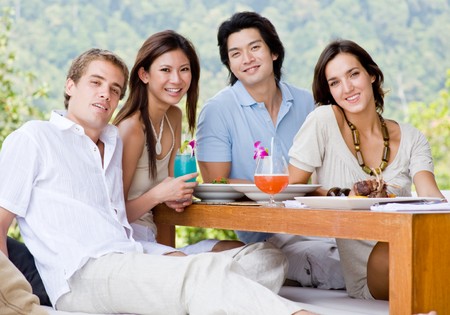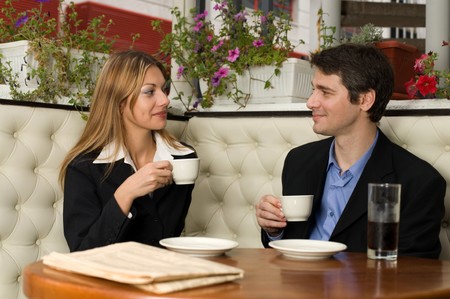Dressing to Dine: Dress codes defined


You have just made at reservation with the restaurant of your dreams. It is a superior steakhouse with dim lighting, a romantic ambiance, and a menu that makes picking an entrée the hardest decision of your life. Its going to be a gala event for you and your guest, and as you allow your mind to foresee the intellectually stimulating and electrifying conversation you’ll be leading over a rich glass of vintage wine and a filet mignon—you realize that you have no idea what to wear. What expectations does a restaurant of such caliber have for their guests? You call the restaurant and ask for the suggested dress, but the standard dress code does not clarify what is expected—it only perplexes you more.
For the most part, restaurant dress expectations can be organized into five categories: casual, business casual, casual elegant, formal, or jacket required. Although these categories can be helpful when preparing for a restaurant visit, they cannot choose the perfect outfit from your closet. What you may need is a guide to help choose a faultless getup for whatever the suggested attire.
Casual
A restaurant that has labeled the dress code as casual may lead guests to believe that the door is left wide open. Yet, as a diner out on the town, keep in mind that when a fine dining restaurant mentions casual, their “casual” expectations are much higher than those of your typical Saturday afternoon on the couch. Your sweats and stained t-shirt are not recommended—you do not want the entrée’s appearance to out-do your own. A casual dress code for fine dining restaurants means comfortable… yet polished. You may want to reference Gap stores, with simple tees or comfy Polo shirts atop fitted jeans, finished with the shoes of your choice. Quoting the more lackadaisical-casual fashions, such as that of Abercrombie and Fitch, where flip-flops and ripped jeans seem to be standard, may not work as well for a fine-dining setting. Think the attire of golf, but not that of surfing.
In defining casual, it may be easier to juxtapose it with what are considered dressier characteristics. Light colors, especially bolds or patterns, are considered more casual than your darks and blacks; and while collared shirts are standard for most fine diners, collarless shirts are only acceptable when casual wear is recommended. Rough fabrics, such as linen and canvas can take an outfit down a couple notches, whereas leather shoes and smooth fabrics will take an outfit up some.
Business Casual
To grasp the concept of outfits that comprise the business casual closet, apply the polished-yet-comfortable look to item you would don to the workplace. Now, understandably, with the plethora of businesses, this dress type becomes obscure, leading to many ideas of what is considered appropriate. The job search engine, Monster.com, offers a definition for this ambiguous category, stating, "In general, business casual means dressing professionally, looking relaxed yet neat and pulled together." The key word in that definition is professional, and when taking clients out to lunch or just meeting someone in general, you want to be apart of the higher stature that the chosen restaurant wants to convey. When recommending business casual, the restaurant most likely wants the guests to feel easful, yet apart of the tip-top dining atmosphere.
For women, business casual comprises suits, collared shirts, knee-length skirts, and tailored dresses. Capris are okay if they are of a dress-pant material, which is usually not denim or heavy cotton (remember rougher fabrics are technically apart of the casual-only category). Tennis shirts and trousers are apart of the business casual’s lower stratum, but just as acceptable. Clothing that reveals too much cleavage, chest, back, stomach, feet or underwear is not befitting for a place of business, nor is it for a business-casual-type setting.
For men, a combination of a collared shirt,which can range from a tenis/Polo shirt or a button down, and dress pants or trousers, such as khakis, all tucked away and made neat with a belt or blazer, is idyllic. The shoes should be in the neighborhood of loafers or tie-ups—sneakers should be excommunicated. Those should always be shed unless entering into a casual-friendly dining milieu In a business-casual work environment, clothing should be pressed and never wrinkled. Convey a professional look, and if you can do that, you won’t have a bit of trouble complying with the restaurants’ recommendations.
Casual Elegant
Now that you saved your jeans and tennies for the casual kitchens, and your blazer and khakis for business-casual settings —what can casual elegant presume? Restaurants calling for this stratum of dress want guests to slip into dressed-up versions of their casual attire. This can vary, depending on the extent an individual wants to dress up. For him, it could be a dark suit or a button down with trousers, made complete by a sportcoat. For her, a formal pants outfit, or a snazzy black dress complemented by an evening wrap or clutch bag would be perfect for such a grand scene. Both women and men will find turtlenecks, darker colors, and leather shoes to be universally accepted as supplements to casual elegant outfits.
Business casual and casual elegant may be troublesome to untwine from each other but the difference lies in the level of personal adornment. Elegant will require more flare, especially for women. You may want to bring out some of the finer jewelry, bolder makeup, and dare to show more skin. Men can don the smoother ties, cufflinks, and may want to wear a black and blue suit before over a gray or tan one.
Formal
Casual elegant is extremely different from formal, so do not bring out your ball gowns for the former category. Those exquisite dresses and tuxedos have a special category all their own, considered formal attire. This category is rare, but when it is suggested, it is imperative that it be followed. The formal standard demands patrons to wear their best, with women in ravishing dresses and men in suits. Formal wear can even go a step above and befall black tie invitations, which call for men to wear tuxedos, and women to wear cocktail or long dresses, or modish, dressy evening separates. A white tie invitation is considered more formal than black tie and requires men to wear full dress, with white tie, vest, and shirt, and women to wear long gowns.
Jacket Required
Usually restaurants calling for jackets required will expect both men and women to be dressed accordingly with formal wear, yet depend on the gentlemen to go the extra mile by wearing a matching jacket. It is suggested that women choose attire that embodies the equivalent of men’s formal suits, while capturing the elegance, more so than the casual, of the casual-elegant category. This elegance can be found in gowns of any length and formal evening separates, including embellished pant suits and decorous dresses with complementing jacket.
Thinking back to that posh date, where you pulled the casual elegance from your closet and allowed yourself to be taken by the flurry of excitement that fine dining can bring, you can understand why dress codes are sometimes suggested by eateries of a certain merit: they wish for their guests to experience the world they have created. You can savor the luxury of top-notch service best when you too look and feel first-rate. The essence of fine dining wants to take patrons out of their ordinary lives, and for two hours, allow them to bask in the extraordinary experience of their choice. To truly be apart of such a supreme culinary happening—one must look the part and one must dress to dine.
Copyright TableAgent.com
© Restaurant Agent Inc.